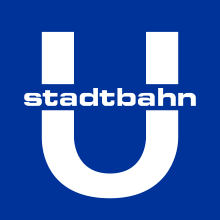
Back Stadtbahn German Stadtbahn Esperanto اشتاتبان Persian Stadtbahn Hungarian Stadtbahn (Germania) Italian シュタットバーン Japanese Stadtbahn LMO Stadtbahn (lightrail) Dutch Штадтбан Russian Mestna železnica Slovenian

Stadtbahn (German pronunciation: [ˈʃtatˌbaːn] ⓘ; German for 'city railway'; plural Stadtbahnen) is a German word referring to various types of urban rail transport. One type of transport originated in the 19th century, firstly in Berlin and followed by Vienna, where rail routes were created that could be used independently from other traffic.
In the 1960s and 1970s, Stadtbahn networks were created again but now by upgrading tramways or light rail lines. This process includes adding segments built to rapid transit standards – usually as part of a process of conversion to a metro railway – mainly by the building of metro-grade tunnels in the central city area.[1] In the first years after the opening of the tunnel sections, often regular trams vehicles (but adapted for tunnel service) were used. These trams were followed by specially designed vehicles like the Stadtbahn B series. By the 1980s virtually all cities had abandoned the long-term goal of establishing a full-scale metro system due to the excessive costs associated with converting the tramways. Most Stadtbahn systems are now a mixture of tramway-like operations in suburban and peripheral areas and a more metro-like mode of operation in city centres, with underground stations. This 20th century Stadtbahn concept eventually spread from Germany to other European countries,[2] where it became known as pre-metro.[3]
- ^ Robert Schwandl (22 Feb 2016), DÜSSELDORF (feat. Wehrhahnlinie), retrieved 2020-08-13,
When I talk about 'Stadtbahn' in this context, I mean those systems which from the late 1960s started to build underground sections to full metro standard, and with the final goal to converting these to full metro operation (like a pre-metro). As we know, none of them actually achieved this initial goal, but all gave up sooner or later.
- ^ Ian Yearsley (21 December 1972). "Trams are coming back". New Scientist. Reed Business Information Ltd. Archived from the original on 2023-01-17. Retrieved 2014-01-14.
But instead of building the entire expensive systems immediately, the Germans hit on the idea of building only the city centre tunnels at first. Intended in the long run to be extended to full undergrounds, in the short term they could be used by trams which would continue to run on the surface outside city centres.
- ^ John Hoyle (16 May 1975). "Letters to the editor -- The tram is the answer". Sydney Morning Herald. Retrieved 2014-01-13.
Cities such as Frankfurt and Cologne in West Germany have further developed their tramway system by introducing a concept known as "premetro." In this system trams or light rail vehicles make extensive use of tunnels, reserve track and by utilizing folding steps these vehicles can operate through high or low stopping places.